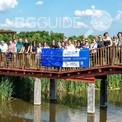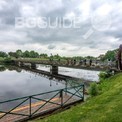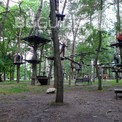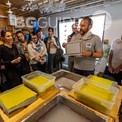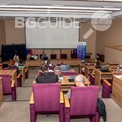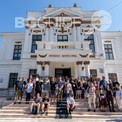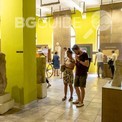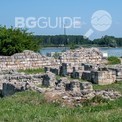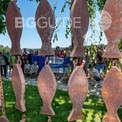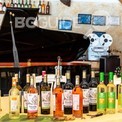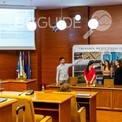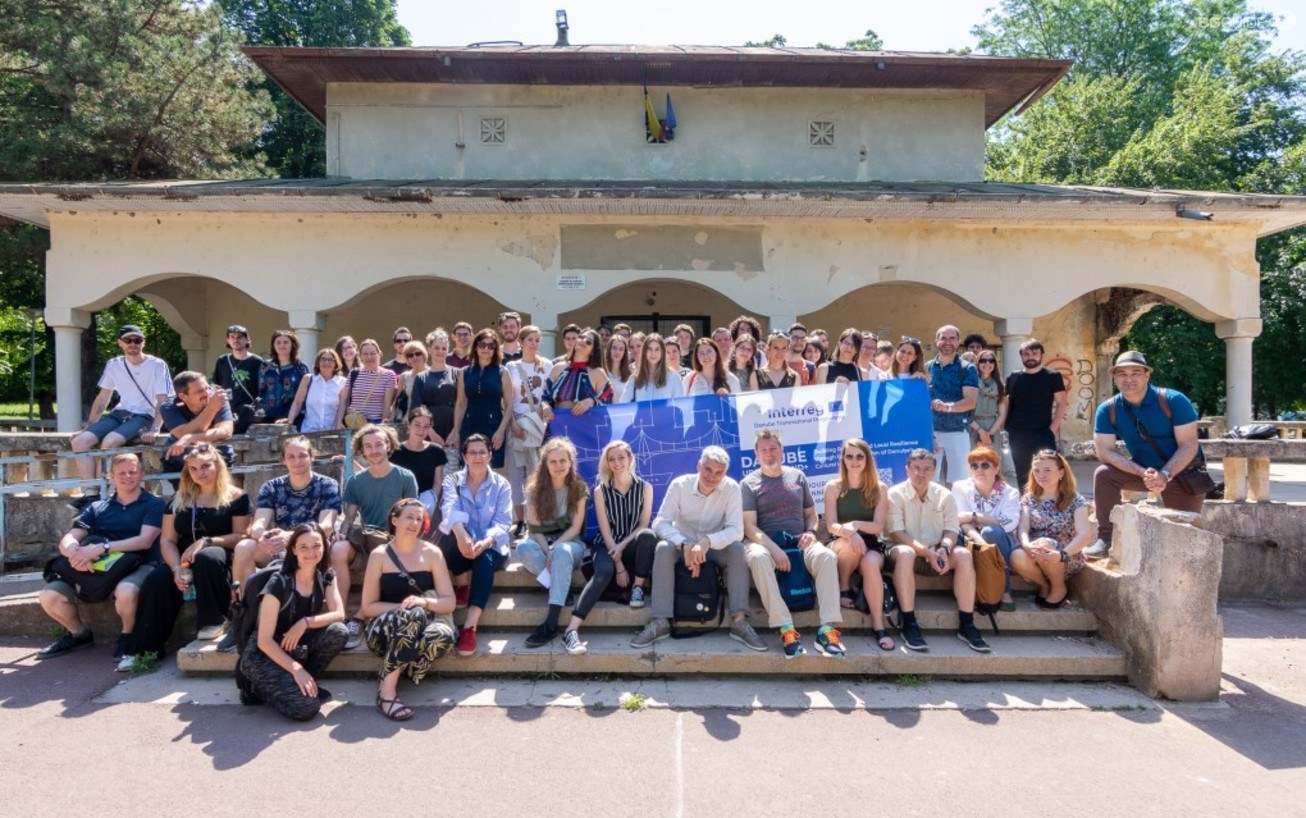
DANURB+ Partners’ Meeting and Shrinking Cities Study Tour in Eastern Romania and Bulgaria, 30.05.–03.06.2022
The partnership got together in the capital of Romania – Bucharest. It is the cultural, industrial, and financial center of the country and from the attractive Unirii Square all participants headed to Calarasi. On the way south everyone enjoyed the beautiful scenery in the region. First stop was Comana Natural Park, which is currently recognized as a wetland of international interest under the Ramsar Convention, part of the European Network of Natura 2000 Protected Areas, as a Bird Protection Site (SPA), and Site of Community Importance (SCI). It houses plants, birds, mammals, fishes, reptiles, invertebrates, and amphibians. Inside the park is Casa Comana offering suitable services for the local community - adventure park with different advantages like 3 types of tree routes with various difficulties among the threes, boat and train trips, playground for kids, tours with electric cars, and so on.
After that, it was time to visit a good practice in the area. The Comana Paper Mill, represented by the Paper Mill Association (Moara de hârtie), has initiated, and is developing The Paper Mill and the Crafts Village Complex in Comana. It consists of 10 creative workshops based on old crafts, that used to be practiced in the Romanian traditional village, such as weaving at a hand loom, reed mace processing, blacksmith, pottery and ceramics, woodwork, traditional cuisine, traditional mill and bakery, as well as book-related crafts like hand-made paper, letterpress printing, and bookbinding.
Next on the route was Gumelnița Museum in Oltenița City. The building was built in 1926 and was originally intended to host cultural events. The museum's collections have increased considerably over the years, nowadays reaching 15 500 archaeological and numismatic objects from different historical periods – Eneolithic, Antiquity, the Gumelniţa civilization, which presentation holds a large space, etc.
On the second day the participants enjoyed the city of Calarasi. The city got its name by the Wallachian princes, in the 17th century, being a station of “mounted couriers’ service” on the route from Bucharest to Constantinople. The service was operated by horseback riders (”călărași”). The Danube borders the city on the south and the planning program pursues better opening to the water, functionalization of the riverbanks and opening to the public. One of the attractions is the Old Post Community Centre that originates from 1883, but the restoration project (2018-2020) has transformed a dilapidated former building into a unique space with information on the history of places and people, opportunities for the acquisition and development of practical skills for children and young people, a place with easy access to online libraries, where citizens have the opportunity to participate in cultural events and workshops. Another attraction is the Municipal Museum of Călărași. Among its many functionalities in its history, including being a City Hall, in 2014 it is the headquarters of the local museum. The museographic exhibition follows, through the objects, the route experienced by a member of the community throughout his life (barber shop, school, corner shop, café, etc.).
Subsequently, it was time to visit some good practices along the area. In the Dichiseni Village, a local producer farm, Puiu Ilisei, one of the most well-known broiler breeders, who started a mushroom farm that sells the production to the supermarkets through the ”Produse românești” label. And Rasova Winery, which is one of the most modern wineries in Romania, built in 2014 under the Dobrogean sun, that is shining over 2100 hours a year, more than in any other part of the country. There is a collection of modern, energetic wines, each telling a fresh red, white, or pink story. The local bridge at night was the perfect addition to enjoying a glass of wine outdoors.
The intensive first two days of travelling were followed by a third day with various project’s workshops and sessions hosted by the Calarasi Municipality City Hall. Discussions were held on important topics related to the project's activities and results: The Action Plans for the pilot sites are underway, so the stakeholders will have the possibility to apply for funding after they are finished; The Quality Label's progress in choosing the best practices for the DANUrB International Association (DIA); Presentation of the new Project Partner URBAN – INCERC; Communication and Promotion for the upcoming events and especially final preparations for the Danube Days; How the ideal city on the Danube looks like and is it possible to exist; And the most important of all, continuing debate on NEXT DANUrB++ project’s ideas, goals, and concept. An exhibition of the sister Erasmus+ Project “Creative Danube" caught the eye of everyone in the lobby of the City Hall.
On the fourth day it was time for some transborder action for the partners, as they took a ferry, crossing the Danube River, and visiting the city of Silistra. The Municipality City Hall hosted a meeting with the Urban Planning and Cultural Heritage Department having a productive discussion on the mutual activities, future plans and possibilities for development.
Afterwards, the participants enjoyed a Pedestrian Guided Walk on a heritage route along the city. In the central part is situated the Southern Fortress Wall and the Gate of Durostorum-Drustar. It is the best-preserved passage from the fortress system of the Durostorum-Drustar Citadel, which is still visible behind the town square. Drastar is the medieval name of the present town of Silistra. It emerged on the foundations of the ancient city of Durostorum, and it was metropolitan center during the Second Bulgarian Kingdom.
The Archaeological Museum of Silistra is located in a building that is a cultural monument. It was built between 1923 and 1926 as a branch of the Romanian National Bank in the town. After 1990 the Archeological Exposition moves in it, as the exhibition includes monuments from Prehistoric, Ancient, and Medieval times (treasure of copper axes and adzes from the 5000 BC, etc.).
Returning to Romania, it was once again time for some wine tasting in Ostrov Winery. The domains derive their essence from the history of the place, which merges with the glory days of the Roman Empire and Ancient Thrace. The owners are developing wine tourism in the region, already having a finished hotel, various guesthouses (with swimming pools), which will be ready until the end of the year, next to a 250-seat restaurant.
On the last day, back in Calarasi, there were several inspirational student presentations on the local and regional planning in shrinking regions. DANUrB+ partners were able to share feedback and evaluate the presented projects, all of them focused on the involvement of the local communities, demonstrating valuable ideas for future development.
The great experiences along the Danube would not have been materialized without the commitment of the local hosts and stakeholders, and the organizers of the whole event - National Institute for Tourism Research and Development and "Ion Mincu" University of Architecture and Urbanism (Romania).
------------------------------------------------------------------------
DANUrB+ project was launched in July 2020 to activate underused cultural heritage and resources on the peripheral and border regions along the Danube River. It is co-financed by the Interreg Danube Transnational Program 2014-2020. The expected result is to increase local development and international tourist attractiveness.
Project co-funded by European Union funds (ERDF and IPA).
